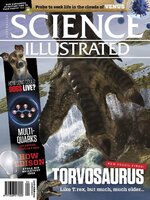Science Illustrated delivers natural science, break through discoveries and an understanding of the world for the entire family. Packed with stunning photography and in-depth editorial it’s a visually spectacular gateway to the world looking into the beginning of life to distant objects in the universe.
SUBSCRIBE TO SCIENCE ILLUSTRATED FOR YOUR CHANCE TO WIN
Science Illustrated
Icy neighbours: Canadians live by floating mountains
Aqua assistant: underwater robot unfolds from torpedo
Evidence of life might be hiding beneath the Martian surface • New experiments down here on Earth indicate that 280-million-year-old bacteria could survive on Mars for millions of years if they are a few metres below the surface. But the scientists also warn of the dangers from interplanetary bacterium contamination.
Rover includes a mobile laboratory • The European ExoMars rover is to search for evidence of life on Mars. It is equipped with scanners, drills, and a compact laboratory.
Did cross-dating hasten extinction for Neanderthals? • A NEW STUDY INDICATES THAT BREEDING BETWEEN NEANDERTHALS AND HOMO SAPIENS WAS A ONE-WAY STREET.
Unknown insect captured in amber • A new species has been added to the mayfly family after microscans and 3D-imaging techniques revealed the fine details of an insect trapped in amber 40 million years ago.
NASA tests supersonic plane • Since 2003, no sound-barrier-breaking airliners have flown. NASA’s X-59 QueSST aircraft is aiming to change that.
Life-spans of bees have halved over 50 years • The life-span of bees has been reduced from about 34 days in the 1970s to 17 today. Scientists think it’s nothing to do with chemicals.
New mountable solar cells are thinner than a human hair • Thin flexible solar cells have the potential to convert almost any surface into a source of energy.
Found: the final ingredient needed for life to exist on Saturn moon • Generous quantities of phosphorus have been discovered on the small Saturn moon of Enceladus. It completes a set of ingredients that make it more likely for life to exist there.
Toilet flush ejects particles at speeds up to 2 metres/s • Research demonstrates how a storm of bacteria is stirred up from the toilet pan to settle in the bathroom.
How many species can be found in a glass of ocean water? • Even a school microscope will reveal a glass of water to be teeming with life. Scientists are now going further, using eDNA sequencing to reveal thousands of species in a single drop.
eDNA sampling can reveal ocean diversity • California-based Illumina is a leader in eDNA sequencing; it was gold sponsor of the Hobart event. Its ‘next-generation sequencing’ workflow involves a three-stage process after sample collection.
What is the point of sinuses? • “I rarely have trouble with my sinuses during the summer, but I don’t look forward to winter, when sinusitis can hit. What are sinuses even doing?”
How can we know Earth’s past? • If scientists’ computer models can’t predict weather more than a few days into the future, how do they claim to predict Earth’s climate and geology from millions of years ago?
Why do we panic in silences during conversations?
Which planet is the coldest in the Solar System? • Obviously it gets hotter closer to the Sun, but the closest and furthest planets aren’t the hottest and coldest. Why?
A maximum price for petrol? • If petrol prices were to keep going up, would the prices reach a maximum at some point?
The world’s top 5 nations by level of oil reserves • In order for petrol prices to be reduced, the nations with the biggest oil reserves need to supply the market with more crude oil.
The dreaded beer gut: why do many older men develop belly fat? • Once men reach...

 Issue 111
Issue 111
 Issue 110
Issue 110
 Issue 109
Issue 109
 Issue 108
Issue 108
 Issue 107
Issue 107
 Issue 106
Issue 106
 Issue 105
Issue 105
 Issue 104
Issue 104
 Issue 103
Issue 103
 Issue 102
Issue 102
 Issue 101
Issue 101
 Issue 100
Issue 100
 Issue 99
Issue 99
 Issue 98
Issue 98
 Issue 97
Issue 97
 Issue 96
Issue 96
 Issue 95
Issue 95
 Issue 94
Issue 94
 Issue 93
Issue 93
 Issue 92
Issue 92
 Issue 91
Issue 91
 Issue 90
Issue 90
 Issue 89
Issue 89
 Issue 88
Issue 88
